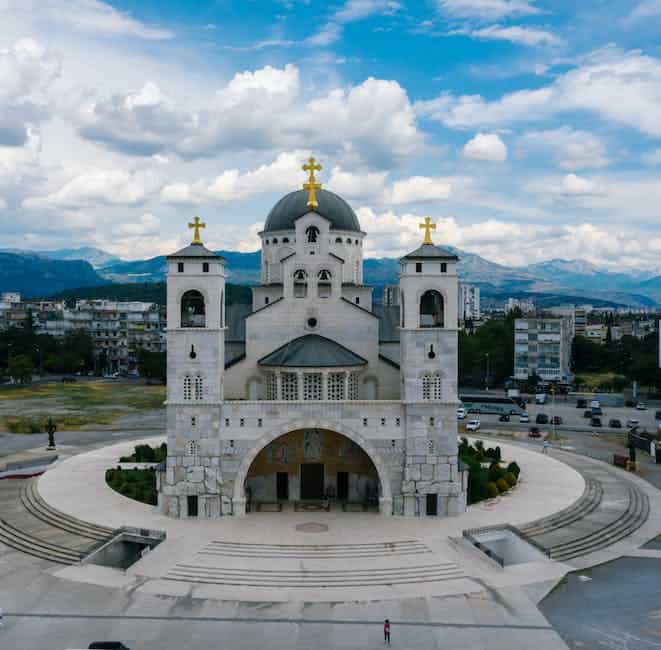
Ah, Podgorica – a city where the whispers of history echo through the streets and the architecture tells a story of resilience and transformation. Nestled in the heart of Montenegro, this city has seen its fair share of change, from ancient Roman ruins to modern-day marvels. Let’s take a stroll down memory lane and explore how Podgorica’s architecture has evolved over the years, shall we?
The Roots of Podgorica: A Historical Tapestry
Imagine walking through the remnants of Doclea, the ancient Roman town. Here, the foundations of Podgorica’s architectural journey were laid. The ruins, though scarce, offer a glimpse into a time when Roman villas dotted the landscape, and public baths were the pinnacle of social life. Fast forward to the Ottoman era, and you’d find a stark contrast with the introduction of oriental designs, minarets reaching for the sky, and stone bridges arching over the Ribnica River.
Transition and Turmoil: The Impact of War
War has a way of reshaping cities, and Podgorica is no exception. The Balkan Wars and World Wars left the city in ruins, with only a few structures standing as silent witnesses to the past. It was during the post-World War Ii reconstruction that Podgorica began to reinvent itself. Brutalist architecture, characterized by raw concrete and geometric forms, became the symbol of a new era, reflecting the city’s determination to rise from the ashes.
The Modern Metamorphosis: A Blend of Old and New
Today, Podgorica is a city in transition, where the old and new coexist in a delicate dance. The Millennium Bridge, a sleek cable-stayed construction, stands as a testament to modern engineering, while the Stara Varoš district retains its Ottoman charm with narrow alleys and quaint houses. The city’s skyline is a mosaic of different eras, each layer adding depth to its architectural narrative.
Podgorica’s Architectural Gems: A Closer Look
Let’s zoom in on some of Podgorica’s architectural highlights. The Cathedral of the Resurrection of Christ, with its intricate frescoes and imposing domes, is a masterpiece of contemporary religious architecture. The King Nikola’s Palace, now a museum, offers a peek into royal life with its blend of neoclassical and secessionist styles. And let’s not forget the Adži-paša’s Bridge, an Ottoman relic that has stood the test of time.
Living Spaces: The Evolution of Residential Architecture
Residential architecture in Podgorica has also undergone significant changes. From traditional Balkan houses to modern apartment complexes, the city’s living spaces reflect the evolving needs and tastes of its residents. The use of glass and steel has increased, bringing a sense of openness and light to urban dwellings. Yet, amidst this modernity, you can still find pockets of history where time seems to stand still.
Green Spaces and Public Places: The Role of Urban Planning
Urban planning plays a crucial role in the fabric of Podgorica’s architecture. The city’s green spaces, like Gorica Hill, provide a natural oasis against the backdrop of urban development. Public squares and parks are carefully designed to offer respite and recreation, fostering a sense of community and belonging among the city’s inhabitants.
Challenges and Opportunities: The Future of Podgorica’s Architecture
As Podgorica continues to grow, it faces challenges like balancing preservation with progress. The city must navigate the demands of modernization while honoring its architectural heritage. Sustainable development and smart city initiatives offer exciting opportunities to shape Podgorica’s future, ensuring that its architecture remains a vibrant and living testament to its storied past.
FAQs About Podgorica’s Architecture
- What architectural styles can be found in Podgorica?
You’ll encounter a mix of Roman, Ottoman, Brutalist, and contemporary styles, each representing different periods in the city’s history.
- Are there any UNESCO World Heritage Sites in Podgorica?
While Podgorica itself doesn’t house any UNESCO sites, it’s a gateway to some of Montenegro’s prized locations, like the stunning Durmitor National Park.
- How has recent development influenced Podgorica’s architecture?
Recent developments have introduced modern aesthetics and technologies, emphasizing sustainability and innovation while respecting the city’s historical context.
Conclusion: A City Carved by Time
In conclusion, Podgorica’s architecture is a rich tapestry woven with threads of history and modernity. From the ancient ruins of Doclea to the cutting-edge designs of the Millennium Bridge, the city’s buildings tell a story of resilience, rebirth, and relentless progress. As we look to the future, we can expect Podgorica to continue evolving, always mindful of its past but eager to embrace new possibilities. It’s this dynamic blend of tradition and innovation that makes Podgorica’s architecture a fascinating subject for anyone interested in the evolution of urban landscapes.
So, whether you’re a history buff, an architecture enthusiast, or simply someone who appreciates the beauty of a city that has stood the test of time, Podgorica’s ever-changing skyline is sure to captivate and inspire. It’s a place where every corner holds a new discovery, and every building has a story to tell. And trust me, those stories are worth listening to.